Foreign Direct Investment in Indiana
Indiana has been one of the nation's top beneficiaries of foreign direct investment. Indiana ranks 14th among states with 148,000 workers employed at firms in which a foreign investor or company had at least a 50 percent stake (i.e., majority-owned U.S. affiliates). Majority-owned U.S. affiliates (MOUSA) accounted for 4.6 percent of Indiana's total private sector employment in 2006 (the most recent data available), ranking ninth nationally and well above the U.S. average (3.5 percent). Furthermore, among its Midwestern neighbors, only Kentucky has a higher share of total private employment in MOUSAs (see Figure 1).
Figure 1: Share of Private Industry Jobs by Majority-Owned U.S. Affiliates in the Midwest Compared to the Nation
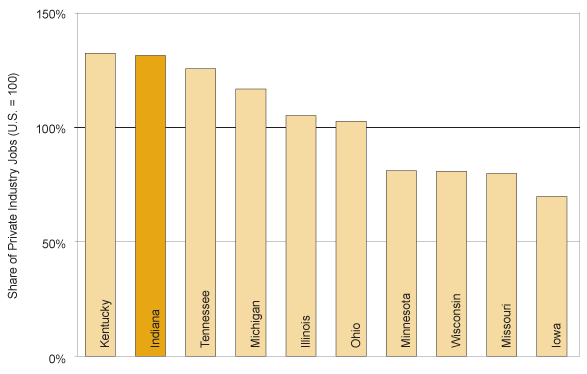
Source: IBRC, using 2006 data from the Bureau of Economic Analysis and Bureau of Labor Statistics
The recent growth in MOUSA employment in Indiana is particularly noteworthy. As Figure 2 shows, following a period of decline early in this decade, 2006 marks the highest MOUSA employment level in the state in recent years. Between 2004 and 2006, Indiana MOUSA employment increased by 14,000 jobs which was the largest gain among neighboring states.1 Employment at the national level also exhibited a post-2004 rebound but still has a ways to go to reach the year 2000 level.
Figure 2: Percent Change in Majority-Owned U.S. Affiliate Employment, Indiana and the United States, 1999 to 2006
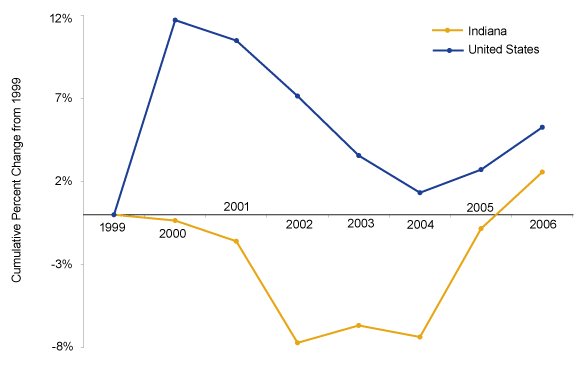
Source: IBRC, using data from the Bureau of Economic Analysis
Indiana ranked seventh nationally in the rate of MOUSA employment growth between 2002 and 2006. As Figure 3 illustrates, the state's average annual growth rate of 2.7 percent made it one of only 20 states to post positive growth. Nationally, MOUSA employment declined over this period at an average annual rate of 0.4 percent. For further context, Indiana's total employment growth rate over this time was just 0.5 percent annually.
Figure 3: Average Annual Percent Change in Majority-Owned U.S. Affiliate Employment, 2002 to 2006
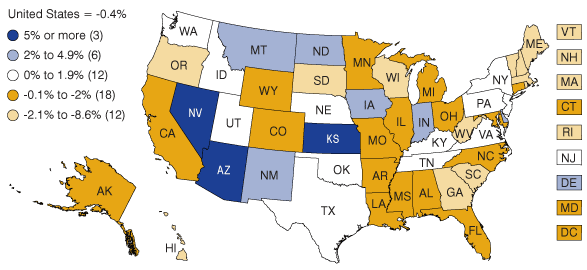
Source: IBRC, using data from the Bureau of Economic Analysis
FDI by Industry
MOUSA manufacturing firms employed 95,900 Hoosiers in 2006, accounting for one of every six manufacturing jobs in the state. The MOUSA's 16.6 percent share of total private manufacturing employment in Indiana far exceeds the U.S. share of 13.9 percent and, among neighboring states, is surpassed by only Michigan, Kentucky and Tennessee.
Manufacturing jobs represent 64.8 percent of total MOUSA employment in Indiana, the second highest share in the nation in 2006 behind Arkansas (see Figure 4). Wholesale trade was Indiana's second largest sector with an 11 percent share of total MOUSA employment. Retail trade followed at 4 percent. MOUSA employment in the United States is distributed more evenly across sectors with manufacturing registering 35 percent of employment, followed by wholesale trade at 12 percent and retail trade at 11 percent.
Figure 4: Majority-Owned U.S. Affiliate Jobs: Manufacturing as a Percent of Total
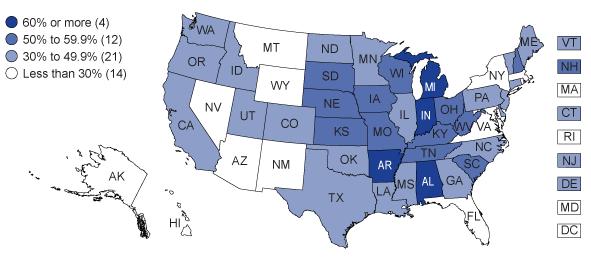
Source: IBRC, using 2006 data from the Bureau of Economic Analysis
FDI by Country of Origin
European companies accounted for 65.4 percent of Indiana's MOUSA employment in 2006 while firms from Asia and the Pacific contributed another 23.5 percent of the total. Europe had an even stronger presence in the United States as a whole in 2006, comprising 67.4 percent of total employment. Figure 5 illustrates that the United Kingdom, Germany and France are the top European sources of MOUSA employment for both the United States and Indiana.
Figure 5: Majority-Owned U.S. Affiliate Employment Contributed by European Parent Companies
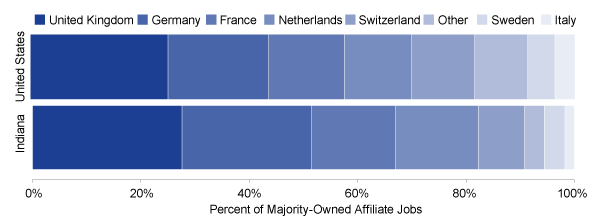
Source: IBRC, using 2006 data from the Bureau of Economic Analysis
While Europe as a region was the dominant source of Indiana's MOUSA employment, Japan was the state's single largest source nation with 33,200 jobs in 2006. This job total represents a 22.4 percent share of Indiana's MOUSA employment which is nearly twice as great as Japan's 11.8 percent share nationally.
Current FDI Prospects
The data series presented thus far runs through 2006, which is the most current FDI data available at the state level. However, the current economic downturn has certainly had a negative impact on existing foreign investments in Indiana—we just do not yet have the data that would tell this story. Data on global FDI activity is slightly more current.
The United Nations Conference on Trade and Development (UNCTAD), in its 2008 World Investment Report, noted that global FDI flows were still quite robust in 2007 hitting a record high of $1.8 trillion. However, in this same report, UNCTAD forecasts that global FDI flows for 2008 will drop to $1.6 trillion, a 10 percent from the 2007 mark. The Organisation for Economic Co-operation and Development (OECD) predicts that FDI inflows to its 29 member nations will decline by 13 percent from 2007 to 2008 while FDI outflows from these same countries are expected to drop 6 percent. The OECD expects even sharper declines in 2009.2
There are some bright spots in the FDI forecast, however. UNCTAD's annual World Investment Prospects Survey, 2008-2010 reports that many transnational corporations (TNCs), while certainly reigning in expectations, remain generally optimistic about near-term FDI activity.3 A survey of 226 TNCs conducted in the second quarter of 2008 found that 68 percent of companies intend to increase investment in the 2008 to 2010 period. The United States ranked as the third-largest likely destination of FDI over this period, behind China and India. Economic conditions have deteriorated considerably since the second quarter of 2008 and, as a result, the next survey may not reflect similar optimism.
Recent FDI Announcements in Indiana
The role of FDI in Indiana is likely to grow given the significant levels of FDI commitments announced in recent years, as tracked by the Indiana Economic Development Corporation (IEDC). Figure 6 is an interactive graphic that shows the location in Indiana and source country for each announcement recorded by the IEDC between 2005 and 2008.
Figure 6: International Investment Commitments in Indiana, 2005 to 2008
Interactive graphic no longer available
The IEDC reports that there were 97 FDI deals announced over this period, worth a combined $7.4 billion and creating an estimated 13,800 jobs.4 Chief among these was British Petroleum's $3 billion investment announcement to reconfigure its facility in Whiting that is expected generate 70 new jobs. Other large FDI deals announced in this time frame include Honda in Greensburg with its expected $550 million investment and 2,100 new jobs, and Nestlé's commitment to invest $338 million and create 340 jobs in Anderson.
Conclusion
Foreign direct investment plays an increasingly important role in Indiana's economy, particularly in the manufacturing sector. For instance, U.S. Bureau of Economic Analysis data for the period 2002 to 2006 show that Indiana's MOUSA manufacturing employment is on the rise even while the state's manufacturing employment overall has declined. Indiana's growth trend also runs contrary to a national decline in MOUSA manufacturing employment over this period. Under normal economic conditions, Indiana's growth in MOUSA employment would seem certain to continue as the significant FDI announcements of 2006 and 2007 are implemented. However, as this is written in the third quarter of 2009, the global economic crisis continues and the future is uncertain. The data presented in this report establish that Indiana is an attractive destination for foreign investment. The question remains as to whether the state will continue to buck the broader FDI employment trends or if economic conditions will negatively affect foreign investments in the state. As more current data become available, we will be better able to chronicle this story.
A complete copy of the Foreign Direct Investment in Indiana report is available online at www.ibrc.indiana.edu/international/pdf/fdi09.pdf.
Notes
- This article often refers to “Indiana's neighbors” as a point of comparison. In each instance, Indiana's neighbors are the same states as those listed in Figure 1: Illinois, Iowa, Kentucky, Michigan, Minnesota, Missouri, Ohio, Tennessee and Wisconsin.
- OECD “Grim Outlook for FDI and Shifting Global Investment Patterns,” Investment News, November 2008, Issue 8. http://www.oecd.org/dataoecd/56/43/41671320.pdf.
- View the World Investment Prospects Survey, 2008-2010 online at https://unctad.org/system/files/official-document/wips2008_en.pdf.
- These numbers represent investment values and job creation targets at the time of the project announcement. It often takes years for these projected numbers to be fully realized, if they are realized at all.
Matt Kinghorn
Demographer, Indiana Business Research Center, Indiana University's Kelley School of Business
